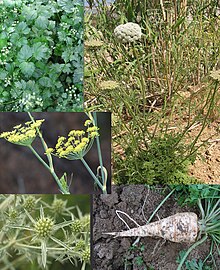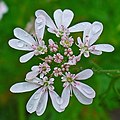Apiaceae
This article includes a list of general references, but it lacks sufficient corresponding inline citations. (November 2013) |
| Carrot family | |
|---|---|

| |
| Umbelliferae: Apium leaves and tiny inflorescences, Daucus habit, Foeniculum inflorescences, Eryngium inflorescences, Petroselinum root. | |
| Scientific classification | |
| Kingdom: | |
| (unranked): | |
| (unranked): | |
| (unranked): | |
| Order: | |
| Family: | Apiaceae (or Umbelliferae) |
| Type genus | |
| Apium | |
| Subfamilies | |
| |
The Apiaceae or Umbelliferae, commonly known as the celery, carrot or parsley family, are a family of mostly aromatic plants with hollow stems. The family, which is named after the type genus Apium, is large, with more than 3,700 species spread across 434 genera; it is the 16th-largest family of flowering plants.[1] Included in this family are the well-known plants: angelica, anise, arracacha, asafoetida, caraway, carrot, celery, Centella asiatica, chervil, cicely, coriander (cilantro), culantro, cumin, dill, fennel, hemlock, lovage, cow parsley, parsley, parsnip, cow parsnip, sea holly, giant hogweed and silphium, a plant whose identity is unclear and which may be extinct.
Description
Most Apiaceae are annual, biennial or perennial herbs (frequently with the leaves aggregated toward the base), though a minority are shrubs or trees. Their leaves are of variable size and alternately arranged, or alternate with the upper leaves becoming nearly opposite. In some taxa, the texture is leathery, fleshy, or even rigid, but always with stomata. They are petiolate or perfoliate and more or less sheathing, the blade usually dissected and pinnatifid, but entire in some genera. Most commonly, crushing their leaves emits a marked smell, aromatic to foetid, but absent in some members. The flowers are nearly always aggregated in terminal umbels, simple or compound, often umbelliform cymes, rarely in heads.
The defining characteristic of this family is the inflorescence: a simple or compound umbel. Flowers across the Apiaceae are fairly uniform and are usually perfect (hermaphroditic) and actinomorphic, but some are andromonoecious, polygamomonoecious, or even dioecious (as in Acronema), with a distinct calyx and corolla, but the calyx is often highly reduced, to the point of being undetectable in many species, while the corolla can be white, yellow, pink or purple. The flowers are nearly perfectly pentamerous, with five petals, sepals, and stamens. The androecium consists of five stamens, but there is often variation in the functionality of the stamens even within a single inflorescence. Some flowers are functionally staminate (where a pistil may be present but has no ovules capable of being fertilized) while others are functionally pistillate (where stamens are present but their anthers do not produce viable pollen). Pollination of one flower by the pollen of a different flower of the same plant (geitonogamy) is common. The gynoecium consists of two carpels fused into a single, bicarpellate pistil with an inferior ovary. When mature, the fused carpels separate into two mericarps. Stylopodiums secrete nectar, attracting pollinators like flies, mosquitoes, gnats, beetles, moths, and bees.
The fruits are nonfleshy schizocarp of two mericarps, each with a single seed; they separate at maturity and are dispersed by wind. Some fruit segments, like those in Daucus spp., are covered in bristles and spread via external transport. The seeds have an oily endosperm[2][3] and generally contain large quantities of fatty oils, with the fatty acid petroselinic acid occurring universally throughout the family while rarely being found outside of the Apiaceae.
Systematics
Apiaceae was first described by John Lindley in 1836.[4] The name is derived from the type genus Apium, which was originally used by Pliny the Elder circa 50 AD for a celery-like plant.[5] The alternative name for the family, Umbelliferae, derives from the inflorescence being generally in the form of a compound umbel. The family was one of the first to be recognized as a distinct group in Jacques Daleschamps' 1586 Historia generalis plantarum. With Robert Morison’s 1672 Plantarum umbelilliferarum distribution nova it became the first group of plants for which a systematic study was published.
The family is solidly placed within the Apiales order in the APG III classification system. It is closely related to Araliaceae and the boundaries between these families remain unclear. Traditionally groups within the family have been delimited largely based on fruit morphology, and the results from this have not been congruent with the more recent molecular phylogenetic analyses. The subfamilial and tribal classification for the family is currently in a state of flux, with many of the groups being found to be grossly paraphyletic or polyphyletic.[1]
Genera
According to the Angiosperm Phylogeny Website as of July 2014[update] 434 genera are in the family Apiaceae.[1]
-
Flowers of Coriandrum sativum
Ecology
The black swallowtail butterfly, Papilio polyxenes, uses the Apiaceae family for food and host plants for oviposition.[7]
Uses
Many members of this family are cultivated for various purposes. The plant structure includes a tap root, which can be large enough to be useful in food, as with parsnips (Pastinaca sativa), carrots (Daucus carota), and Hamburg parsley (Petroselinum crispum). Many plants of this group are also adapted to conditions that encourage heavy concentrations of essential oils, and as a result some are flavourful aromatic herbs. Examples are parsley (Petroselinum crispum), coriander (Coriandrum sativum), culantro, and dill (Anethum graveolens). The plentiful seeds of the umbels, likewise, are sometimes used in cuisine, as with, coriander (Coriandrum sativum), fennel (Foeniculum vulgare), cumin (Cuminum cyminum), and caraway (Carum carvi).
Other notable cultivated Apiaceae include chervil (Anthriscus cerefolium), angelica (Angelica spp.), celery (Apium graveolens), arracacha (Arracacia xanthorrhiza), poison hemlock (Conium maculatum), sea holly (Eryngium spp.), asafoetida (Ferula asafoetida), galbanum (Ferula gummosa), cicely (Myrrhis odorata), anise (Pimpinella anisum), lovage (Levisticum officinale), and hacquetia (Hacquetia epipactis).[2]
Cultivation
Generally, all members of this family are best cultivated in the cool-season garden; indeed, they may not grow at all if the soils are too warm. Almost every widely cultivated plant of this group is a considered useful as a companion plant. One reason is because the tiny flowers clustered into umbels, are well suited for ladybugs, parasitic wasps, and predatory flies, which actually drink nectar when not reproducing. They then prey upon insect pests on nearby plants. Some of the members of this family considered "herbs" produce scents that are believed to mask the odours of nearby plants, thus making them harder for insect pests to find.
Other uses
The poisonous members of the Apiaceae have been used for a variety of purposes globally. The poisonous Oenanthe crocata has been used to stupefy fish, Cicuta douglasii has been used as an aid in suicides, and arrow poisons have been made from various other family species.
Daucus carota has been used as coloring for butter and its roots used as a coffee substitute.
Dorema ammoniacum, Ferula galbaniflua, and Ferula sumbul are sources of incense.
The woody Azorella compacta Phil. has been used in South America for fuel.
Chemistry
Apiaceae vegetables including carrot, celery, fennel, parsley and parsnip, contain polyynes, an unusual class of organic compounds that show cytotoxic activities.[8][9] Many species contain coumarins or coumarin derivatives, such as furanocoumarins.
See also
References
- ^ a b c Stevens, P.F. (2001 onwards). Angiosperm Phylogeny Website. Version 9, June 2008.
- ^ a b Watson, L., Dallwitz, M.J. (1992 onwards) The families of flowering plants: descriptions, illustrations, identification, and information retrieval. Version: 4 March 2011.
- ^ She, M., Pu, F., Pan, Z., Watson, M., Cannon, J.F.M., Holmes-Smith, I., Kljuykov, E.V., Phillippe, L.R., Pimenov, M.G. (2005). "Apiaceae". Flora of China. 14: 1–205.
{{cite journal}}: CS1 maint: multiple names: authors list (link) - ^ Lindley, J. (1836) An Introduction to the Natural System of Botany, 2nd Edition. Longman, London.
- ^ Michael G. Simpson (20 July 2010). Plant Systematics. Academic Press. ISBN 978-0-12-374380-0. Retrieved 14 April 2012.
- ^ Woodville, W. (1793) Medical Botany. James Phillips, London.
- ^ Hall, Donald W. 2011 "Featured Creatures - Eastern Black Swallowtail." Entomology and Nematology Department, University of Florida. http://entnemdept.ufl.edu/creatures/bfly/bfly2/eastern_black_swallowtail.htm#life
- ^ Polyacetylenes from the Apiaceae Vegetables Carrot, Celery, Fennel, Parsley, and Parsnip and Their Cytotoxic Activities. Christian Zidorn, Karin Jöhrer, Markus Ganzera, Birthe Schubert, Elisabeth Maria Sigmund, Judith Mader, Richard Greil, Ernst P. Ellmerer and Hermann Stuppner, J. Agric. Food Chem., 2005, 53 (7), pages 2518–2523, doi:10.1021/jf048041s
- ^ Minto, Robert E.; Blacklock, Brenda J “Biosynthesis and function of polyacetylenes and allied natural products” From Progress in Lipid Research 2008, vol. 47, 233-306. doi:10.1016/j.plipres.2008.02.002
Further reading
- Apiaceae. 2011. Utah State University Intermountain Herbarium. 20 October 2011. http://herbarium.usu.edu/taxa/apiaceae.htm
- Constance, L. (1971). "History of the classification of Umbelliferae (Apiaceae)." in Heywood, V. H. [ed.], The biology and chemistry of the Umbelliferae, 1–11. Academic Press, London.
- Cronquist, A. (1968). The Evolution and Classification of Flowering Plants. Boston: Houghton Mifflin.
- French, D. H. (1971). "Ethnobotany of the Umbelliferae." in Heywood, V. H. [ed.], The biology and chemistry of the Umbelliferae, 385–412. Academic Press, London.
- Hegnauer, R. (1971) "Chemical Patterns and Relationships of Umbelliferae." in Heywood, V. H. [ed.], The biology and chemistry of the Umbelliferae, 267–277. Academic Press, London.
- Heywood, V. H. (1971). "Systematic survey of Old World Umbelliferae." in Heywood, V. H. [ed.], The biology and chemistry of the Umbelliferae, 31–41. Academic Press, London.
- Judd, W. S. et al. (1999). Plant Systematics: A Phylogenetic Approach. Sunderland, MA: Sinauer Associates, Inc.
- Plunkett, G. M.; Downie, S. R. (1999). "Major lineages within Apiaceae subfamily Apioideae: a comparison of chloroplast restriction site and DNA sequence data". American Journal of Botany. 86: 1014–1026. doi:10.2307/2656619.
- Plunkett, G. M.; Soltis, D. E.; Soltis, P. S. (1996). "Higher Level Relationships of Apiales (Apiaceae and Araliaceae) Based on Phylogenetic Analysis of rbcL Sequences". Botanical Society of America. 83 (4): 499–515. doi:10.2307/2446219.
- Plunkett, G. M.; Soltis, D. E.; Soltis, P. S. (1996). "Evolutionary Patters in Apiaceae: Inferences Based on matK Sequence Data". American Society of Plant Taxonomists. 21 (4): 477–495. doi:10.2307/2419610.
- Nieto Feliner, Gonzalo; Jury, Stephen Leonard & Herrero Nieto, Alberto (eds.) Flora iberica. Plantas vasculares de la Península Ibérica e Islas Baleares. Vol. X. "Araliaceae-Umbelliferae" (2003) Madrid: Real Jardín Botánico, CSIC (in Spanish).
External links
|
|


![Anise (Pimpinella anisum) from Woodville (1793)[6]](http://upload.wikimedia.org/wikipedia/commons/thumb/0/0c/Apiaceae_Pimpinella_anisum.jpg/91px-Apiaceae_Pimpinella_anisum.jpg)

